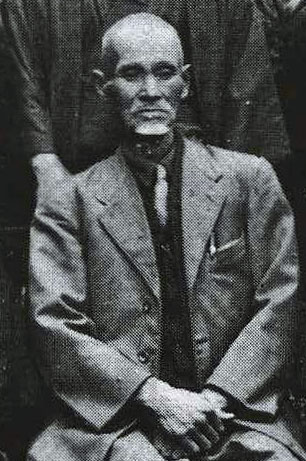- Kentsū Yabu
Infobox_martial_artist
name = Kentsū Yabu
residence =
other_names =

imagesize =
caption = Yabu Kentsu, c. 1936
birth_name =
birth_date = 1866
birth_place =Shuri ,Okinawa flagicon|Ryūkyū Kingdom|1429
death_date = 1937
death_place =Shuri ,Okinawa ,Japan flagicon|Japan
martial_art =Shorin-ryu Karate
teacher =Matsumura Sokon
rank =
students =Makoto Gima ,Richard Kim nihongo|Kentsū Yabu|屋部 憲通|Yabu Kentsū|1866 - 1937 was a prominent teacher ofShorin-ryu karate inOkinawa from the 1910s until the 1930s, and was among the first people to demonstrate karate inHawaii .History
Yabu was born in
Shuri , Okinawa, in 1866. He was the oldest son of Yabu Kenten and Shun Morinaga. He had three brothers, three sisters, and three half-sisters. [Yabu, Kenjiro. "Genealogy of the Surname So Family (from Kengi the Founder): The Okushima Family Line, An Annotated Text," translated with supplementary notes by Ben Kobashigawa and Yoko Fukumura, May 31, 1986.]As a young man, Yabu received training in Shorin-ryu karate. His teachers were both Matsumura Sokon and Itosu Anko. [Hokama, Tetsuhiro. "History and Traditions of Okinawan Karate," translated by Cezar Borkowski. Hamilton, Ontario: Masters Publication, 1998, p. 35.] [Lowry, Dave. "Yabu Kentsu, An Okinawan Karateman," "Karate Illustrated," 7, 1985, p. 11.]
Yabu joined the Japanese Army in 1891. He served in
Manchuria during theFirst Sino-Japanese War of 1894-1895. He received promotion to lieutenant, but to subsequent students, he was often known as "gunso", or sergeant.Svinth, Joseph R. (2003) "Karate Pioneer Kentsu Yabu, 1866-1937." [http://ejmas.com/jcs/jcsart_svinth_0603.htm] ]Following separation from the service, Yabu studied at Shuri's Prefectural Teacher's Training College, and in 1902, he became a teacher at Shuri's Prefectural School Number One.Noble, Graham, with McLaren, Ian and Karasawa, N. "Masters of the Shorin-ryu, Part II," "Fighting Arts International", 51, 9:3, 1988, pp. 32-35. [http://seinenkai.com/articles/noble/noble-shorin2.html] ]
In 1908, Yabu's oldest son, Kenden, went to Hawaii. In 1912, Kenden went to
California . In the USA, Kenden Yabu became known as Kenden Yabe, after a method oftransliteration then being used on Japanese passports."History of the Okinawans in North America", translation of "Hokubei Okinawajin shi," translated by Ben Kobashigawa. Los Angeles: University of California and the Okinawan Club of America, 1988.]In 1919, Kenden Yabe married, and in 1921, his wife became pregnant. Yabu Kentsu immediately went to California to visit his son (and, hopefully, grandson). However, Kenden Yabe and his wife only had daughters. Thus, Yabu Kentsu went back to Okinawa disappointed."History of the Okinawans in North America", translation of "Hokubei Okinawajin shi," translated by Ben Kobashigawa. Los Angeles: University of California and the Okinawan Club of America, 1988.] Svinth, Joseph R. (2003) "Karate Pioneer Kentsu Yabu, 1866-1937." [http://ejmas.com/jcs/jcsart_svinth_0603.htm] ]
Yabu visited the United States twice, once during 1921-1922, and again in 1927. During the second visit, he returned to Okinawa via
Hawaii . He spent about nine months in the Territory. He spent most of his time onOahu , but he also visited other islands. InHonolulu , he gave two public demonstrations of karate at the NuuanuYMCA . [Goodin, Charles. (2003) "Hawaii Karate Seinenkai Salutes Kentsu Yabu 1866-1937." [http://seinenkai.com/salute-yabu.html] ]In 1936, Yabu visited Tokyo. While there, he visited the young
Shoshin Nagamine , who later became another well-known karate teacher. [Bishop, Mark. "Okinawan Karate: Teachers, Styles and Secret Techniques". London: A. & C. Black, 1989, p. 86.]Yabu died at Shuri, Okinawa, in 1937.
Influence on Karate
As a former soldier, Yabu has been credited with helping make Okinawan karate training more militaristic. That is, students were expected to line up in rows, and respond by the numbers. If so, this was probably part of the general militarization of Japanese athletics common during the early 20th century. [Abe, Ikuo, Kiyohara,Yasuharu, and Nakajima, Ken. "Sport and Physical Education under Fascistization in Japan," "Bulletin of Health & Sport Sciences, University of Tsukuba", 13, 1990, pp. 25-46. [http://ejmas.com/jalt/jaltart_abe_0600.htm] ] However, there is no doubt that his methods involved much rote repetition.Noble, Graham, with McLaren, Ian and Karasawa, N. (1988). "Masters of the Shorin-ryu, Part II," "Fighting Arts International", 51, 9:3, 1988, pp. 32-35. [http://seinenkai.com/articles/noble/noble-shorin2.html] ]
His favorite
kata reportedly includedgojushiho andnaihanchi .Noble, Graham, with McLaren, Ian and Karasawa, N. (1988). "Masters of the Shorin-ryu, Part II," "Fighting Arts International", 51, 9:3, 1988, pp. 32-35. [http://seinenkai.com/articles/noble/noble-shorin2.html] ]References
Wikimedia Foundation. 2010.
